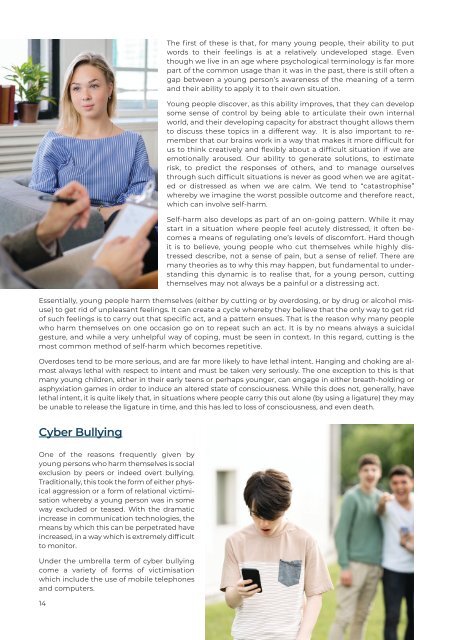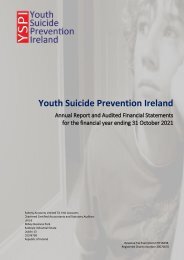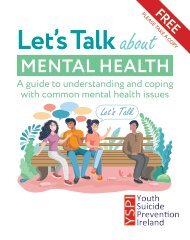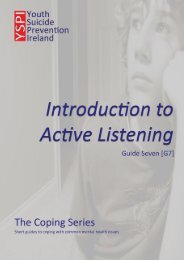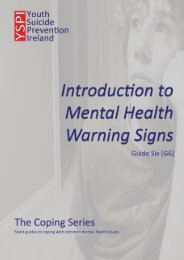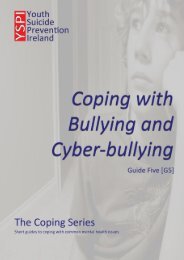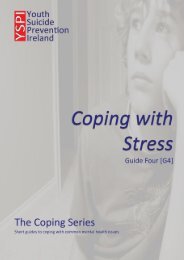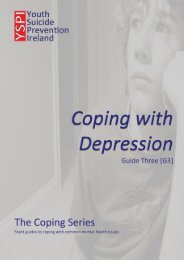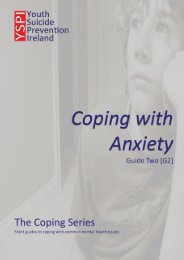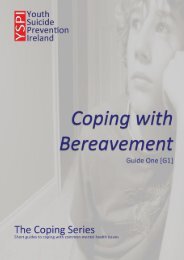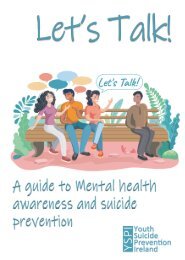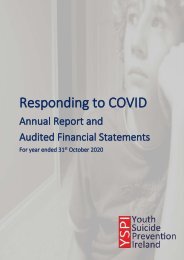Guidance and Information for Teachers and Lecturers
Teachers' guide to youth mental health and suicide prevention, now in it's 10th edition. Topics covered in this guide include: * Introduction to youth mental health awareness * Awareness of mental health risk factors * Recognising the symptoms of mental health issues * Helping someone with mental health issues * Understanding the dangers: Cyber-bullying Online Dangers Locked-away Syndrome * Supporting and developing coping strategies * Warnings signs of suicidal thoughts * Suicide Prevention and intervention * How to help and get help * Child Protection Policies
Teachers' guide to youth mental health and suicide prevention, now in it's 10th edition.
Topics covered in this guide include:
* Introduction to youth mental health awareness
* Awareness of mental health risk factors
* Recognising the symptoms of mental health issues
* Helping someone with mental health issues
* Understanding the dangers:
Cyber-bullying
Online Dangers
Locked-away Syndrome
* Supporting and developing coping strategies
* Warnings signs of suicidal thoughts
* Suicide Prevention and intervention
* How to help and get help
* Child Protection Policies
- No tags were found...
You also want an ePaper? Increase the reach of your titles
YUMPU automatically turns print PDFs into web optimized ePapers that Google loves.
The first of these is that, <strong>for</strong> many young people, their ability to put<br />
words to their feelings is at a relatively undeveloped stage. Even<br />
though we live in an age where psychological terminology is far more<br />
part of the common usage than it was in the past, there is still often a<br />
gap between a young person’s awareness of the meaning of a term<br />
<strong>and</strong> their ability to apply it to their own situation.<br />
Young people discover, as this ability improves, that they can develop<br />
some sense of control by being able to articulate their own internal<br />
world, <strong>and</strong> their developing capacity <strong>for</strong> abstract thought allows them<br />
to discuss these topics in a different way. It is also important to remember<br />
that our brains work in a way that makes it more difficult <strong>for</strong><br />
us to think creatively <strong>and</strong> flexibly about a difficult situation if we are<br />
emotionally aroused. Our ability to generate solutions, to estimate<br />
risk, to predict the responses of others, <strong>and</strong> to manage ourselves<br />
through such difficult situations is never as good when we are agitated<br />
or distressed as when we are calm. We tend to “catastrophise”<br />
whereby we imagine the worst possible outcome <strong>and</strong> there<strong>for</strong>e react,<br />
which can involve self-harm.<br />
Self-harm also develops as part of an on-going pattern. While it may<br />
start in a situation where people feel acutely distressed, it often becomes<br />
a means of regulating one’s levels of discom<strong>for</strong>t. Hard though<br />
it is to believe, young people who cut themselves while highly distressed<br />
describe, not a sense of pain, but a sense of relief. There are<br />
many theories as to why this may happen, but fundamental to underst<strong>and</strong>ing<br />
this dynamic is to realise that, <strong>for</strong> a young person, cutting<br />
themselves may not always be a painful or a distressing act.<br />
Essentially, young people harm themselves (either by cutting or by overdosing, or by drug or alcohol misuse)<br />
to get rid of unpleasant feelings. It can create a cycle whereby they believe that the only way to get rid<br />
of such feelings is to carry out that specific act, <strong>and</strong> a pattern ensues. That is the reason why many people<br />
who harm themselves on one occasion go on to repeat such an act. It is by no means always a suicidal<br />
gesture, <strong>and</strong> while a very unhelpful way of coping, must be seen in context. In this regard, cutting is the<br />
most common method of self-harm which becomes repetitive.<br />
Overdoses tend to be more serious, <strong>and</strong> are far more likely to have lethal intent. Hanging <strong>and</strong> choking are almost<br />
always lethal with respect to intent <strong>and</strong> must be taken very seriously. The one exception to this is that<br />
many young children, either in their early teens or perhaps younger, can engage in either breath-holding or<br />
asphyxiation games in order to induce an altered state of consciousness. While this does not, generally, have<br />
lethal intent, it is quite likely that, in situations where people carry this out alone (by using a ligature) they may<br />
be unable to release the ligature in time, <strong>and</strong> this has led to loss of consciousness, <strong>and</strong> even death.<br />
Cyber Bullying<br />
One of the reasons frequently given by<br />
young persons who harm themselves is social<br />
exclusion by peers or indeed overt bullying.<br />
Traditionally, this took the <strong>for</strong>m of either physical<br />
aggression or a <strong>for</strong>m of relational victimisation<br />
whereby a young person was in some<br />
way excluded or teased. With the dramatic<br />
increase in communication technologies, the<br />
means by which this can be perpetrated have<br />
increased, in a way which is extremely difficult<br />
to monitor.<br />
Under the umbrella term of cyber bullying<br />
come a variety of <strong>for</strong>ms of victimisation<br />
which include the use of mobile telephones<br />
<strong>and</strong> computers.<br />
14


